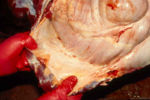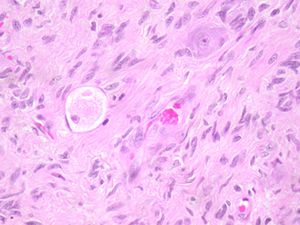Category:Obstruction, Intestinal
Intestinal obstruction can be the sequel to either mechanical or functional causes. Mechanical obstruction occurs due to physical blockage of the intestinal lumen whereas functional obstruction results from a decrease or inhibition of intestinal motility due to loss of smooth muscle contraction (Brown et. al, 2007).
Mechanical Obstruction
- Acute of chronic mechanical obstruction of the intestine can occur in all species.
- Acute obstruction usually involves the upper or middle small intestine
- Chronic obstruction typically occurs in the distal small intestine or large intestine.
- Three main categories of causes of obstruciton:
- Intraluminal
- E.g. foreign bodies, food impaction.
- Intramural
- E.g. neoplasia
- Extrinsic
- E.g. adhesions, neoplasia and prostate enlargement.
- Intraluminal
Intraluminal Obstruction
Foreign Bodies
- Foreign bodies of all types can be found in the intestines.
- While some may pass through posing no problems, others can cause acute obstruction,
- Quite common in dogs
- Rare in other species - tend to lodge in the oesophagus or in one of the ruminant stomachs.)
- Enteroliths can be seen in horses greater than 4 years of age.
- Are stones consisting of magnesium ammonium phosphate around a central nidus (often a metallic foreign body)
- Typically lodge at the pelvic flexure or the transverse colon.
- Clinical
- Obstruction at pylorus produces repeated vomiting.
- Obstrustion lower down gives less dramatic effect.
- Is still a problem if in the middle of the small intestines.
- May be vague signs; some vomiting and off food.
- Diagnosis
- May not show up well radiographically (unless radio-opaque) for several days.
- May also be objects that are semi solid or soft, e.g.
- String
- Plastic bags
- Stringy things, like pieces of material- particularly in puppies.
- May also be objects that are semi solid or soft, e.g.
- Make all of intestines have knotted appearance.
- May be seen in horses with baler twine.
- May not show up well radiographically (unless radio-opaque) for several days.
- Pathogenesis
- Smooth, round objects, such as golf balls, lodge especially near the pylorus or lower down.
- Occasionally in cattle (piece of rope or piece of tarpaulin) produces a tangled mass in rumen.
- Cause pressure necrosis and eventually perforation.
- Foreign bodies can also be chronic, remaining for long periods of time without causing disturbance.
Impaction
- Impaction of the colon can occur in all species.
- Dog and cat - main cause is dehydrated faecal material.
- Horse - faeces, digesta, sand, or fibrous material can all contribute.
- There are certain predisposing factors:
- Poor dentition
- Water deprivation
- A high roughage diet
- General debility.
- There are certain predisposing factors:
- Antihelminthic administration or large parasite burdens can also lead to impaction.
Extrinsic Obstruction
- Obstruction of the intestine due to external factors such as tumours, abscesses, and fibrous adhesions is a common occurrence.
Inflammatory Adhesions
- Arise following gut perforation, peritonitis or surgery.
- Consist of fibrous tissue bands that may:
- Restrict intestinal motility
- Cause kinks in the mesentery.
Prostatic Enlargement
- In the dog
- Can lead to compression of the rectum
Neoplasia
- Neoplasi in structures adjacent to the intestines can spread and cause external compression.
- Pancreatic tumours in particular can extend and impinge on the duodenum.
- Pedicles of tumours such as lipomas in horses can become wound in loops of intestine leading to obstruction and possible strangulation.
- Clinical
- Pathogenesis
- Seen occasionally in cat (rarer in dog)
- Usually towards end of intestines
- E.g. at the ileocaecocolic valve.
- Gut proximal to tumour becomes thickened due to hypertrophy of smooth muscle as a result of trying to force ingesta past progessively narrowing lumen.
- Produces "hose pipe intestine".
- Seen with carcinoma, lymphoma, leiomyoma and other tumours.
Functional Obstruction
Paralytic Ileus
- A common condition.
- Occurs following trauma or abdominal surgery.
- Stasis of gut flow due to failure of peristalsis.
- Leads to distension with gas and fluid, as well as a flaccid intestinal wall.
Causes
- Anything which stops peristalsis, e.g.
- Damage to nerve supply to intestine (autonomic nervous system)
- Pain
- Abnormal metabolism
- Toxaemia
- Electrolyte imbalance such as hypocalcaemia, hypomagnesaemia, and hypokalaemia.
- Also in
- Diabetes mellitus
- Uraemia
- Tetanus
- Lead poisoning.
Pathology
- loss of smooth muscle tone leads to a flaccid bowel.
- Bowel is distended with fluid.
Pathogenesis
- Intestine susceptible to neurogenic damage during an operation.
- Peristalsis fades away over a few days producing paralytic (adynamic) ileus.
- Particularly occurs if bowel handled roughly, or if serosa gets cold and dry at surgery.
- Very difficult to start peristalsis again but will sometimes respond to pharmacological or electrical stimulation.
- The horse is very susceptible, and the dog is somewhat suscpeitble.
Dysautonomia
- Most notably affects horses and cats.
Equine dysautonomia, or grass sickness
- Most prevalent in the UK and western Europe.
- Common in wetter areas, e.g. the South West.
- Seen in horses out at pasture in late summer and autumn.
- Usually affects young adults.
- 6-7 years old.
- Clinical
- Acute oneset:
- Muscular tremors
- Abdominal pain
- Does not eat
- Constipation
- Become severly tympanic in acute cases
- Dull and restless
- Avoid swallowing
- Salivate excessively
- Degenerative lesions are seen in the autonomic nerve ganglia, including enteric plexuses
- May either:
- Progress rapidly to death
- Take a slower clinical course.
- Eat a bit, but food drops out of mouth
- Go on to die slowly.
- Some horses recover
- This is very unlikely, and the condition is usually fatal.
- Clinically difficult to diagnose - signs are confined to the gut.
- Easy to diagnose on post mortem
- Acute oneset:
- Pathology
- Stomach and small intestine large amounts of contain watery yellow fluid.
- There is an abrupt change in the large intestine, where no fluid is present.
- large intestine has very dry mucoid contents.
- There is an abrupt change in the large intestine, where no fluid is present.
- Stomach and small intestine large amounts of contain watery yellow fluid.
- Pathogenesis
- Due to functional obstruction at ileocaecal valve and a degree of paralytic ileus of the small intestine.
- The exact cause is unknown, but a type of bacterial or fungal toxin which may damage autonomic nervous system ganglia may be involved.
- Clostridium botulinum is thought to be involved.
- A similar condition seen in hares
- Certain yeares almost seem to have outbreaks.
- Certain pastures at certain times of year produce grass sickness quite often.
- A definitive diagnosis must be made - if the condition is due to the grazing we need to know.
- E.g. if on livery or stud grazing, may put people off going there.
- A definitive diagnosis must be made - if the condition is due to the grazing we need to know.
- 'Diagnosis
- At post mortem look for degenerative changes in coeliaco-mesenteric ganglia - need to examine histologically.
- Ganglia are peanut sized and found in perirenal fat between adrenal gland and the aorta.
- At post mortem look for degenerative changes in coeliaco-mesenteric ganglia - need to examine histologically.
Feline dysautonomia, or Key-Gaskell Syndrome
- Occurs mostly in the UK and continental Europe.
- Is also of unknown aetiology. Suggested causative factors include:
- Environmental toxins
- Infectious agents
- Botulinum toxins .
- Clinical signs:
- Anorexia
- Depression
- Bradycardia
- Decreased lacrimation,
- Altered pupillary dilataion,
- Megaoesophagus
- Constipation.
- Degenerative lesions of autonomic nerve ganglia can be seen.
- Also occurs in the oesophagus.
Subcategories
This category has the following 2 subcategories, out of 2 total.


